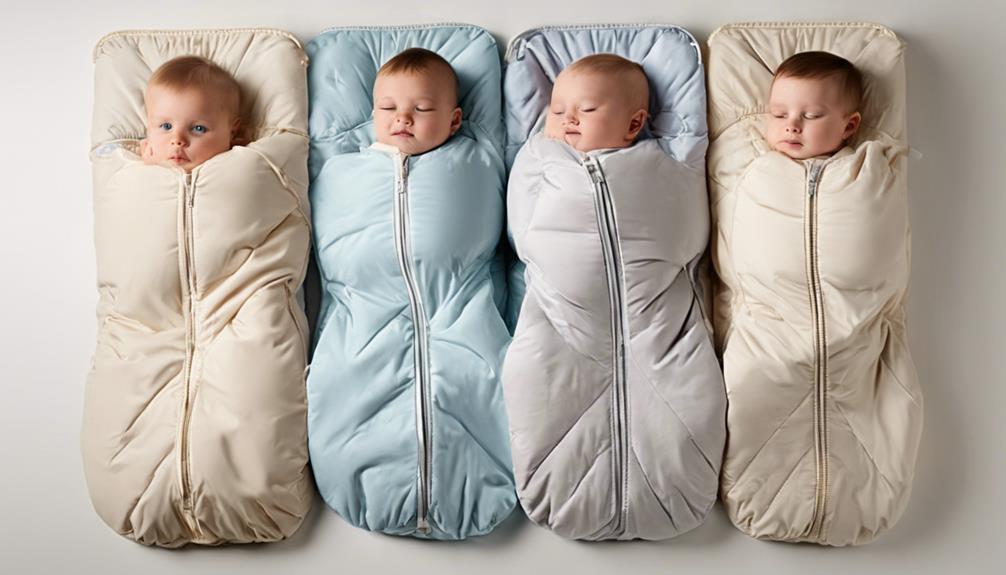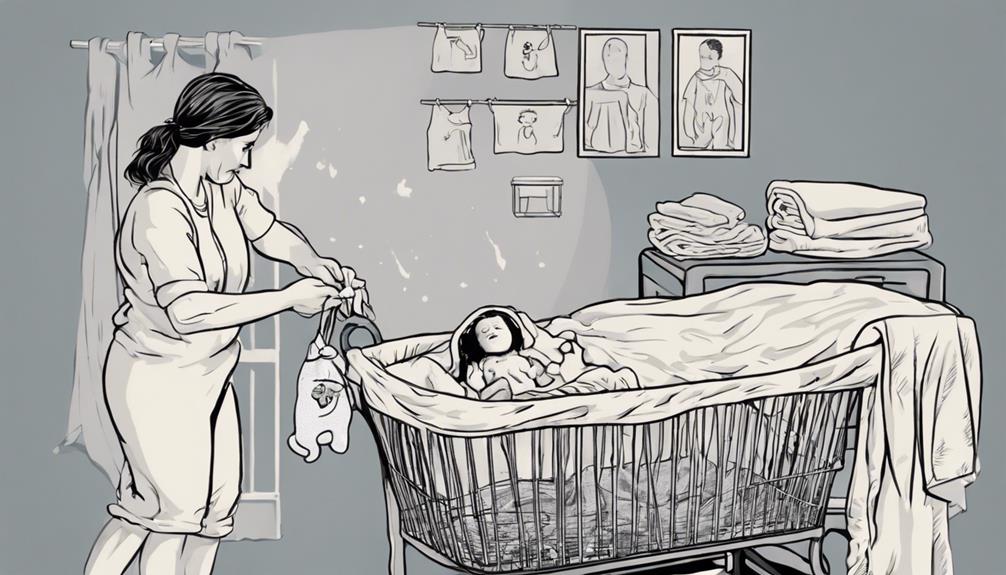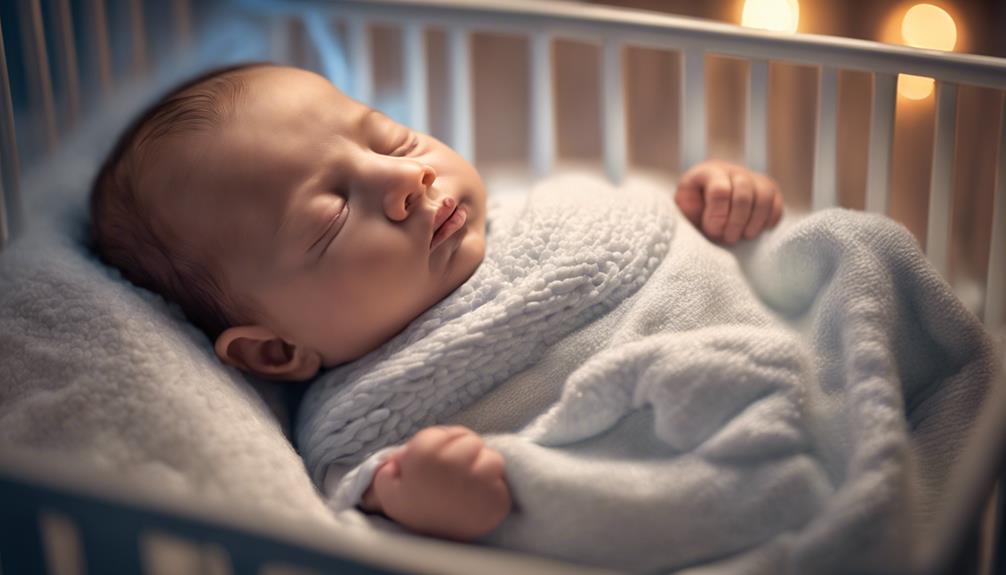Picture this situation where a mother, we’ll name her Sarah, is worried about her infant’s sleep safety. She has heard about sleep sacks but is uncertain about the recommended practices to ensure her baby sleeps well and securely.
How can Sarah navigate the world of sleep sacks to make the best choice for her little one? Let's explore key considerations and expert advice that can guide caregivers like Sarah in providing peak sleep conditions for their newborns.
Key Takeaways
- Ensure a snug fit to prevent suffocation risks and promote safe sleep.
- Choose the right TOG rating for optimal warmth based on room temperature.
- Prioritize breathable fabrics and secure closures for airflow and safety.
- Monitor wear and tear for maintenance and transition to blankets when ready.
Benefits of Sleep Sacks
As parents, we appreciate the benefits of using sleep sacks to guarantee our newborns sleep safely and comfortably. Sleep sacks create a safe sleep environment by eliminating loose bedding in cribs, reducing the risk of suffocation and ensuring our little ones can breathe easily throughout the night. They also provide consistent warmth, maintaining a comfortable temperature for our babies to sleep soundly. When zipped up, these cozy cocoons cue the brain for sleep, helping infants understand it's bedtime—a wonderful tool for establishing a bedtime routine.
Additionally, sleep sacks offer enhanced safety by discouraging climbing out of the crib, providing a secure sleeping experience for our little adventurers. They're recommended by the American Academy of Pediatrics as a reliable way to reduce the risk of Sudden Infant Death Syndrome (SIDS) and provide a cozy sleeping solution that promotes a peaceful night's sleep for both babies and parents.
Selecting the Right Sleep Sack

To guarantee your newborn's safety and comfort during sleep, it's critical to carefully select the right sleep sack based on factors like age, weight, and room temperature. When choosing a sleep sack, consider the following essential points:
- Confirm Fit: Confirm the sleep sack fits your baby correctly to prevent any potential hazards during sleep.
- Appropriate TOG: Select a sleep sack with the right TOG rating suitable for the room temperature to keep your baby cozy without overheating.
- Breathable Fabrics: Opt for sleep sacks made from breathable fabrics to promote airflow and reduce the risk of overheating.
- Safety Standards: Look for sleep sacks that meet safety standards, including snug fit, secure closures, and non-toxic materials for a safe sleeping environment.
Using Sleep Sacks Safely
Ensuring the snug fit of the sleep sack around your baby is essential to minimize suffocation risks and promote safe sleep practices. When using sleep sacks, it's important that they fit snugly without being too tight.
Look for ones with properly sized arm openings to prevent your baby from slipping down inside the sack and to ensure proper ventilation. Opt for sleep sacks with well-designed zippers to reduce skin contact and potential irritation. Make sure the materials used meet safety standards, especially concerning flammability.
Additionally, select a sleep sack with a neckline design that offers a secure fit without causing any discomfort to your little one. By paying attention to these details, you can create a safe sleep environment for your baby while using sleep sacks.
Maintaining Sleep Sack Hygiene

To maintain hygiene when using sleep sacks, it's important to wash them regularly in hot water to eradicate germs and eliminate dirt accumulation. Using a mild detergent is crucial to prevent skin irritation and preserve the quality of the fabric. After washing, guarantee the sleep sack is dried thoroughly to prevent mold growth and musty odors. Avoid using fabric softeners and bleach as they can compromise the integrity of the sleep sack material. Regularly inspect the sleep sack for any signs of wear and tear to confirm its safety for use.
- Wash sleep sacks regularly in hot water to kill germs and remove dirt.
- Use a mild detergent to prevent skin irritation and maintain fabric quality.
- Dry sleep sacks thoroughly to prevent mold growth and musty odors.
- Avoid fabric softeners and bleach to preserve the integrity of the sleep sack material.
Transitioning Out of Sleep Sacks

When phasing out of sleep sacks, parents should consider their child's readiness cues and introduce alternative bedding options like lightweight blankets. Shifting typically occurs around 2-3 years old when children move to a toddler bed. Signs of readiness include outgrowing sleep sacks or expressing discomfort. Introducing a lightweight blanket post-sleep sack phase helps maintain comfort and warmth. Encouraging independence, involve toddlers in selecting their bedtime attire. Gradually shifting out of sleep sacks aligns with the child's developmental milestones and sleep preferences.
| Signs of Readiness | Shift Age | Bedding Options |
|---|---|---|
| Outgrowing Sacks | 2-3 years old | Lightweight Blankets |
| Expressing Discomfort | 2-3 years old | Toddler Bed |
| Developmental Milestones | 2-3 years old | Comfort and Warmth |
| Sleep Preferences | 2-3 years old | Independence |
Frequently Asked Questions
Is It Safe for Newborns to Sleep in a Sleep Sack?
Yes, it's safe for newborns to sleep in a sleep sack if it fits properly. Some babies may prefer swaddling initially, as it mimics the womb, but sleep sacks can be great for those who dislike feeling restricted.
Do Pediatricians Recommend Sleep Sacks?
Yes, pediatricians recommend sleep sacks for newborns. They are a safe sleep practice endorsed by the AAP, reducing SIDS risks. Using sleep sacks eliminates loose bedding hazards in cribs, regulates temperature, and promotes healthy sleep habits.
What Should a Newborn Wear in a Sleep Sack?
Wondering what a newborn should wear in a sleep sack? We recommend a lightweight, sleeveless cotton option to keep them cozy without overheating. Remember, snug fit is key for safety. Stick to one layer underneath for best comfort and ventilation.
What Are the Rules for Baby Sleep Sack?
We follow strict guidelines for baby sleep sacks: snug fit for safety, correct usage is essential, arm openings for ventilation, easy diaper changes with good zippers, secure neckline for comfort. Always prioritize your baby's safety and comfort.
Is Using Sleep Sacks for Newborns a Safe Alternative to Swaddling?
Yes, using sleep sacks for newborns can help newborn sleep naturally without the risk of overheating or loose blankets that come with traditional swaddling. Sleep sacks provide a safe and comfortable environment for babies to sleep in, allowing them to rest peacefully throughout the night.
Conclusion
To sum up, it's evident that using a sleep sack can offer numerous benefits for newborns, from promoting safe sleep to aiding in temperature regulation.
By selecting the right sleep sack, using it safely, and maintaining proper hygiene, caregivers can guarantee their little ones have a comfortable and secure sleep environment.
Remember, moving out of sleep sacks should be done gradually to guarantee a smooth adjustment for your baby. Let's continue to prioritize their safety and well-being as they grow.










